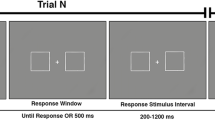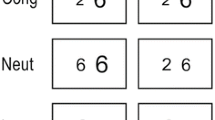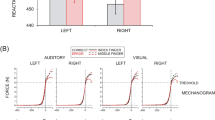Abstract
Recent studies implicate a common response monitoring system, being active during erroneous and correct responses. Converging evidence from time–frequency decompositions of the response-related ERP revealed that evoked theta activity at fronto-central electrode positions differentiates correct from erroneous responses in simple tasks, but also in more complex tasks. However, up to now it is unclear how different electrophysiological parameters of error processing, especially at the level of neural oscillations are related, or predictive for BOLD signal changes reflecting error processing at a functional-neuroanatomical level. The present study aims to provide crosslinks between time domain information, time–frequency information, MRI BOLD signal and behavioral parameters in a task examining error monitoring due to mistakes in a mental rotation task. The results show that BOLD signal changes reflecting error processing on a functional-neuroanatomical level are best predicted by evoked oscillations in the theta frequency band. Although the fMRI results in this study account for an involvement of the anterior cingulate cortex, middle frontal gyrus, and the Insula in error processing, the correlation of evoked oscillations and BOLD signal was restricted to a coupling of evoked theta and anterior cingulate cortex BOLD activity. The current results indicate that although there is a distributed functional-neuroanatomical network mediating error processing, only distinct parts of this network seem to modulate electrophysiological properties of error monitoring.





Similar content being viewed by others
Notes
Here, all extracted frequency bands from the sLORETA analysis were tested separately. Note that as described in the “Methods” section that bootstrap tests were conducted. These bootstrapped the whole data matrix, thus Type I errors can be controlled.
References
Alexander WH, Brown JW (2011) Medial prefrontal cortex as an action-outcome predictor. Nat Neurosci 14:1338–1344
Allen PJ, Polizzi G, Krakow K, Fish DR, Lemieux L (1998) Identification of EEG events in the MR scanner: the problem of pulse artifact and a method for its subtraction. Neuroimage 8:229–239
Allen PJ, Josephs O, Turner R (2000) A method for removing imaging artifact from continuous EEG recorded during functional MRI. Neuroimage 12:230–239
Amari SI (1998) Natural Gradient Works Efficiently in Learning. Neural Comput 10:251–276
Beste C, Saft C, Yordanova J, Andrich J, Gold R, Falkenstein M, Kolev V (2007) Functional compensation or pathology in cortico-subcortical interactions in preclinical Huntington’s disease? Neuropsychologia 45:2922–2930
Beste C, Saft C, Konrad C, Andrich J, Habbel A, Schepers I, Jansen A, Pfleiderer B, Falkenstein M (2008) Levels of error processing in Huntington’s disease: a combined study using event-related potentials and voxel-based morphometry. Hum Brain Mapp 29:121–130
Beste C, Willemssen R, Saft C, Falkenstein M (2009) Error processing in normal aging and in basal ganglia disorders. Neuroscience 159:143–149
Beste C, Baune BT, Domschke K, Falkenstein M, Konrad C (2010a) Dissociable influences of NR2B-receptor related neural transmission on functions of distinct associative basal ganglia circuits. Neuroimage 52:309–315
Beste C, Domschke K, Kolev V, Yordanova J, Baffa A, Falkenstein M, Konrad C (2010b) Functional 5-HT1a receptor polymorphism selectively modulates error- specific subprocesses of performance monitoring. Hum Brain Mapp 31:621–630
Beste C, Kolev V, Yordanova J, Domschke K, Falkenstein M, Baune BT, Konrad C (2010c) The role of the BDNF Val66Met polymorphism for the synchronization of error-specific neural networks. J Neurosci 30:10727–10733
Beste C, Güntürkün O, Baune BT, Domschke K, Falkenstein M, Konrad C (2011) Double dissociated effects of the functional TNF-alpha -308G/A polymorphism on processes of cognitive control. Neuropsychologia 49:196–202
Brett M, Anton J-L, Valabregue R, Poline J-B (2002) Region of interest analysis using an SPM toolbox. International Conference on Functional Mapping of the Human Brain, Sendai
Briselli E, Garreffa G, Bianchi L, Bianciardi M, Macaluso E, Abbafati M, Marciani MG, Maraviglia B (2006) An independent component analysis-based approach on ballistocardiogram artifact removing. Magn Reson Imaging 24:393–400
Brookings T, Ortigue S, Grafton S, Carlson J (2009) Using ICA and realistic BOLD models to obtain joint EEG/fMRI solutions to the problem of source localization. Neuroimage 44:411–420
Cavanagh JF, Cohen MX, Allen JJ (2009) Prelude to and resolution of an error: EEG phase synchrony reveals cognitive control dynamics during action monitoring. J Neurosci 29(1):98–105
Cavanagh JF, Zambrano-Vazquez L, Allen JJ (2012) Theta lingua franca: a common mid-frontal substrate for action monitoring processes. Psychophysiology 49(2):220–238
Cohen MX (2011) Error-related medial frontal theta activity predicts cingulate-related structural connectivity. NeuroImage 55(3):1373–1383
Comon P (1994) Independent component analysis—a new concept? Signal Process 36:287–314
Dammers J, Schiek M, Boers F, Silex C, Zvyagintsev M, Pietrzyk U, Mathiak K (2008) Integration of amplitude and phase statistics for complete artifact removal in independent components of neuromagnetic recordings. IEEE Trans Biomed Eng 55(10):2353–2362
Debener S, Ullsperger M, Siegel M, Fiehler K, von Cramon DY, Engel AK (2005) Trial-by-trial coupling of concurrent electroencephalogram and functional magnetic resonance imaging identifies the dynamics of performance monitoring. J Neurosci 25:11730–11737
Dehaene S, Posner M, Tucker DM (1994) Localization of an neural system for error detection and compensation. Psychol Sci 5:303–305
Delorme A, Makeig S (2004) EEGLAB: an open source toolbox for analysis of single-trial EEG dynamics including independent component analysis. J Neurosci Method 134:9–21
Efron B, Tibshirani RJ (1993) An Introduction to the Bootstrap. Chapman and Hall, New York
Falkenstein M, Hohnsbein J, Hoomann J, Blanke L (1990) Psychophysiological Brain Research. In: Brunia CHM, Gaillard AWK, Kok A (eds) Tilburg University Press, Tilburg, pp 192–195
Gehring WJ, Goss B, Coles MGH, Meyer DE, Donchin E (1993) A neural system for error-detection and compensation. Psychol Sci 4:385–390
Heil M (2002) The functional significance of ERP effects during mental rotation. Psychophysiology 39:535–545
Heil M, Wahl K, Herbst M (1999) Mental rotation, memory scanning, and the central bottleneck. Psychol Res 62:48–61
Hester R, Foxe JJ, Molholm S, Shpaner M, Garavan H (2005) Neural mechanisms involved in error processing: a comparison of errors made with and without awareness. Neuroimage 27:602–608
Hoffmann S, Falkenstein M (2008) The Correction of Eye Blink Artefacts in the EEG: a Comparison of Two Prominent Methods. PLoS One 3:e3004
Hoffmann S, Falkenstein M (2010) Independent component analysis of erroneous and correct responses suggests online response control. Hum Brain Mapp 31:1305–1315
Hoffmann S, Falkenstein M (2011) Aging and error processing: age related increase in the variability of the error-negativity is not accompanied by increase in response variability. PLoS One 6:e17482
Hoffmann S, Wascher E (2012) Spatial cueing modulates the monitoring of correct responses. Neurosci Lett 506:225–228
Holroyd CB, Coles MG (2002) The neural basis of human error processing: reinforcement learning, dopamine, and the error-related negativity. Psychol Rev 109:679–709
Holroyd CB, Yeung N (2003) Alcohol and error processing. Trends Neurosci 26:402–404
Huiskamp GJM (2005) Reduction of the Ballistocardiogram Artifact in Simultaneous EEG-fMRI using ICA. Conf Proc IEEE Eng Med Biol Soc 4:3691–3694
Jung TP, Humphries C, Lee TW, Makeig S, McKeown MJ, Iragui V, Sejnowski T (1998) Extended ICA removes artifacts from electroencephalographic recordings. Advances in Neural Information Processing Systems. MIT Press, Cambridge
Jung TP, Makeig S, McKeown MJ, Bell AJ, Lee TW, Sejnowski TJ (2001) Imaging brain dynamics using independent component analysis. Proc IEEE 89:1107–1122
Keil J, Weisz N, Paul-Jordanov I, Wienbruch C (2010) Localization of the magnetic equivalent of the ERN and induced oscillatory brain activity. Neuroimage 51(404):411
Klein TA, Endrass T, Kathmann N, Neumann J, von Cramon DY, Ullsperger M (2007) Neural correlates of error awareness. Neuroimage 34:1774–1781
Lee TW, Girolami M, Sejnowski TJ (1999) Independent component analysis using an extended infomax algorithm for mixed subgaussian and supergaussian sources. Neural Comput 11:417–441
Lee JH, Oh S, Jolesz FA, Park H, Yoo SS (2009) Application of independent component analysis for the data mining of simultaneous Eeg-fMRI: preliminary experience on sleep onset. Int J Neurosci 119:1118–1136
Li Y, Ma Z, Lu W, Li Y (2006) Automatic removal of the eye blink artifact from EEG using an ICA-based template matching approach. Physiol Meas 27(4):425–436
Liotti M, Pliszka SR, Perez R, Kothmann D, Woldorff MG (2005) Abnormal brain activity related to performance monitoring and error detection in children with ADHD. Cortex 41:377–388
Luu P, Tucker DM (2001) Regulating action: alternating activation of midline frontal and motor cortical networks. Clin Neurophysiol 112(7):1295–1306
Luu P, Tucker DM, Makeig S (2004) Frontal midline theta and the error-related negativity: neurophysiological mechanisms of action regulation. Clin Neurophysiol 115(8):1821–1835
Maier ME, Yeung N, Steinhauser M (2011) Error-related brain activity and adjustments of selective attention following errors. Neuroimage 56(4):2339–2347
Mallet S (1999) A theory for multi-resolution signal decomposition: the wavelet representation. IEEE 7:674–693
Marques JP, Rebola J, Figueiredo P, Pinto A, Sales F, Castelo-Branco M (2009) ICA decomposition of EEG signal for fMRI processing in epilepsy. Hum Brain Mapp 30:2986–2996
Mathalon DH, Fedor M, Faustman WO, Gray M, Askari N, Ford JM (2002) Response-monitoring dysfunction in schizophrenia: an event-related brain potential study. J Abnorm Psychol 111:22–41
Michels L, Lüchinger R, Koenig T, Martin E, Brandeis D (2012) Developmental changes of BOLD signal correlations with global human EEG power and synchronization during working memory. PLoS One 7(7):e39447
Moosmann M, Schonfelder VH, Specht K, Scheeringa R, Nordby H, Hugdahl K (2009) Realignment parameter-informed artefact correction for simultaneous EEG- fMRI recordings. Neuroimage 45:1144–1150
Nieuwenhuis S, Ridderinkhof KR, Talsma D, Coles MG, Holroyd CB, Kok A, van der Molen MW (2002) A computational account of altered error processing in older age: dopamine and the error-related negativity. Cogn Affect Behav Neurosci 2:19–36
Nunez PL, Srinivasan R, Westdorp AF, Wijesinghe RS, Tucker DM, Silberstein RB, Cadusch PJ (1997) EEG coherency. I: statistics, reference electrode, volume conduction, Laplacians, cortical imaging, and interpretation at multiple scales. Electroencephalogr Clin Neurophysiol 103:499–515
Pailing PE, Segalowitz SJ (2004) The effects of uncertainty in error monitoring on associated ERPs. Brain Cogn 56:215–233
Pailing PE, Segalowitz SJ, Dywan J, Davies PL (2002) Error negativity and response control. Psychophysiology 39:198–206
Perrin F, Pernier J, Bertrand O, Echallier JF (1989) Spherical splines for scalp potential and current density mapping. Electroencephalogr Clin Neurophysiol 72:184–187
Prime D, Jolicoeur P (2009) Mental rotation requires visual short-term memory: evidence from human electric cortical activity. J Cogn Neurosci 22:2437–2446
Prime D, Dell’Acqua R, Arguin M, Gosselin F, Jolicoeur P (2011) Spatial layout of letters in nonwords affects visual short-term memory load: evidence from human electrophysiology. Psychophysiology 48:430–436
R Development Core Team (2012). R: A language and environment for statistical computing. R Foundation for Statistical Computing, Vienna, Austria. ISBN 3-900051-07-0, url: http://www.R-project.org
Rasheed T, Lee YK, Lee SY, Kim TS (2009) Attenuation of artifacts in EEG signals measured inside an MRI scanner using constrained independent component analysis. Physiol Meas 30:387–404
Ratcliff R, Rouder JN (1998) Modeling response times for two-choice decisions. Psychol Sci 9:347
Ridderinkhof KR, Ullsperger M, Crone EA, Nieuwenhuis S (2004) The role of the medial frontal cortex in cognitive control. Science 306:443–447
Roger C, Benar CG, Vidal F, Hasbroucq T, Burle B (2010) Rostral Cingulate Zone and correct response monitoring: ICA and source localization evidences for the unicity of correct- and error-negativities. Neuroimage 51:391–403
Sauseng P, Griesmayr B, Freunberger R, Klimesch W (2010) Control mechanisms in working memory: a possible function of EEG theta oscillations. Neurosci Biobehav Rev 34:1015–1022
Scheeringa R, Fries P, Petersson K-M, Oostenveld R, Grothe I, Norris DG, Hagoort P, Bastiaansen MCM (2011) Neuronal dynamics underlying high- and low- frequency EEG oscillations contribute independently to the human BOLD signal. Neuron 69:572–583
Talairach J, Tournoux P (1988) Co-planar stereotaxic atlas of the human brain. Thieme, New York
Trujillo LT, Allen JJB (2007) Theta EEG dynamics of the error-related negativity. Clin Neurophysiol 118(3):645–668
Ullsperger M, von Cramon DY (2003) Error monitoring using external feedback: specific roles of the habenular complex, the reward system, and the cingulate motor area revealed by functional magnetic resonance imaging. J Neurosci 23:4308–4314
Ullsperger M, Harsay HA, Wessel JR, Ridderinkhof KR (2010) Conscious perception of errors and its relation to the anterior insula. Brain Struct Funct 214:629–643
Vidal F, Burle B, Bonnet M, Grapperon J, Hasbroucq T (2003) Error negativity on correct trials: a reexamination of available data. Biol Psychol 64:265–282
Wascher E, Reinhard M, Wauschkuhn B, Verleger R (1999) Spatial S-R compatibility with centrally presented stimuli. An event-related asymmetry study on dimensional overlap. J Cogn Neurosci 11(2):214–229
Willemssen R, Müller T, Schwarz M, Falkenstein M, Beste C (2009) Response monitoring in de novo patients with Parkinson’s disease. PloS One 4:e4898
Yordanova J, Falkenstein M, Hohnsbein J, Kolev V (2004) Parallel systems of error processing in the brain. Neuroimage 22:590–602
Zimmer HD (2008) Visual and spatial working memory: from boxes to networks. Neurosci Biobehav Rev 32:1373–1395
Acknowledgments
This research was supported by Grants from the Deutsche Forschungsgemeinschaft (DFG); BE 4045/6-2 and BE 4045/10-1 to C·B. and WA 987/14-1 to E.W.
Author information
Authors and Affiliations
Corresponding author
Additional information
S. Hoffmann and C. Beste contributed equally to the manuscript.
Rights and permissions
About this article
Cite this article
Hoffmann, S., Labrenz, F., Themann, M. et al. Crosslinking EEG time–frequency decomposition and fMRI in error monitoring. Brain Struct Funct 219, 595–605 (2014). https://doi.org/10.1007/s00429-013-0521-y
Received:
Accepted:
Published:
Issue Date:
DOI: https://doi.org/10.1007/s00429-013-0521-y




